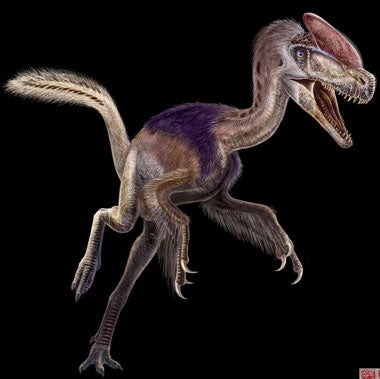Father of Tyrannosaurus is unearthed in China

A scientific analysis of the fossilised remains has revealed the creature lived some 160 million years ago, about 90 million years before T. rex, and had an ornamental bony crest on its nose.
Scientists believe that the dinosaur belongs to the same group of extinct animals that gave rise to T. rex. Like other tyrannosaurs, it was a carnivore that walked on two legs, although it was substantially smaller than its more famous cousin.
A study by Chinese and American scientists, published today in the journal Nature, described the anatomy of the new dinosaur, which they have named Guanlong wucaii, or "crowned dragon of the five-coloured rocks".
The scientists, led by Xing Xu of the Institute of Vertebrate Palaeontology and Palaeoanthropology in Beijing, found two relatively complete fossilised skeletons of the dinosaur in the coloured layers of rock that form the "badlands" of Xinjiang province in the far western region of China. Adult Guanlongs grew to a length of about 10ft, which probably meant that the dinosaur was a "secondary predator" to a larger species of meat-eater called Monolophosaurus which lived in the region at the same time.
"This is the best look so far at the ancestral condition from which the tyrant dinosaurs, T. rex and company, evolved," said Thomas Holtz, a specialist at the University of Maryland.
"The new 'crowned dragon' of Xinjiang is simply the latest discovery on the trail leading back to the origin of the tyrant kings," Dr Holtz said.
The unusual nasal crest does not appear to perform any practical function other than as an ornament for courtship displays, similar to the tail of the peacock or the antlers of an elk, the scientists said in Nature.
"Guanlong's cranial ornament may be a sexually selected trait, which has also been a suggested explanation for similar structures in some other non-avian dinosaur groups," the scientists said.
Dr Holtz said the nasal crest is the most spectacular feature of Guanlong, especially impressive because of its tall, narrow projection of bone with numerous hollow excavations.
"The fragile nature of these structures suggests that they served for visual signalling, so for species recognition and mating displays, rather than as weapons," Dr Holtz said.
Guanlong stood about 3ft tall at the hip and had relatively long, three-fingered arms rather than the stubby two-fingered forelimbs of T. rex. The scientists suspect it also had feathers, as did related dinosaurs of the time. T. rex, by comparison, stood more than 20ft tall and was at least 40ft long.
By studying its detailed anatomy, scientists hope that Guanlong will help them to understand how these large predatory creatures evolved over the course of more than 100 million years.
Subscribe to Independent Premium to bookmark this article
Want to bookmark your favourite articles and stories to read or reference later? Start your Independent Premium subscription today.

Join our commenting forum
Join thought-provoking conversations, follow other Independent readers and see their replies